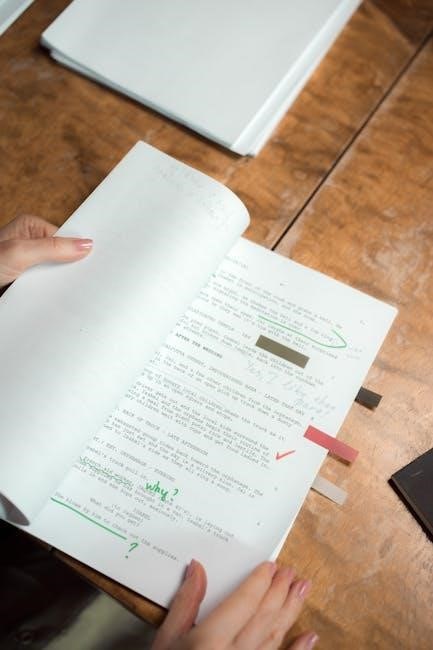Key Stage 2 guided reading is a core component of the National Curriculum, focusing on developing comprehension skills through group reading sessions facilitated by teachers.
1.1 Definition and Purpose
Guided reading is an educational strategy where students read texts in small groups while receiving teacher support. It aims to enhance reading comprehension, fluency, and critical thinking. The purpose is to create a collaborative environment where students engage with diverse texts, fostering a deeper understanding of literature and preparing them for independent reading. This approach is tailored to meet individual needs, ensuring all learners progress effectively.
1.2 Importance in the Curriculum
Guided reading bridges the gap between teacher instruction and independent learning, enhancing comprehension, fluency, and critical thinking. It supports differentiated instruction, allowing teachers to cater to diverse reading levels. By fostering collaboration and a love for reading, guided reading prepares students for lifelong learning and intellectual growth, making it a vital part of the Key Stage 2 curriculum.
Benefits of Guided Reading
Guided reading enhances comprehension, fluency, and critical thinking, fostering a lifelong love for reading and preparing students for academic success and personal growth.
2.1 Academic Benefits
Guided reading significantly enhances reading comprehension, fluency, and vocabulary. It helps students develop critical thinking skills, fostering deeper understanding of texts. By focusing on specific strategies, pupils improve their ability to retrieve information, make inferences, and analyze content. Regular sessions align with curriculum goals, ensuring steady progress and improved academic performance. This structured approach also builds confidence and prepares students for independent reading and lifelong learning.
2.2 Social and Emotional Benefits
Guided reading fosters a supportive classroom environment, encouraging collaboration and empathy. Students develop social skills through group discussions, building confidence in expressing ideas. It helps reluctant readers feel included and valued, promoting emotional well-being. By sharing perspectives, pupils enhance their understanding of diverse viewpoints, fostering empathy and teamwork. This collaborative approach also strengthens teacher-student relationships, creating a positive learning atmosphere.
Structure of a Guided Reading Session
A guided reading session typically includes an introduction, reading, and reflection. The teacher introduces the text, students read independently or aloud, and the group discusses key points.
3.1 Preparation and Planning
Effective preparation is crucial for a successful guided reading session. Teachers select appropriate texts aligned with learning objectives and assess students’ reading levels to group them accordingly. They plan focused questions to guide discussion and deepen comprehension. Preparation also involves creating a supportive environment, ensuring all materials are ready, and setting clear expectations. This structured approach ensures sessions are engaging and purposeful, catering to diverse learner needs.
3.2 Execution and Facilitation
During execution, the teacher introduces the text, setting context and purpose. Students read aloud or silently, with the teacher observing and supporting as needed. Open-ended questions are posed to deepen understanding, fostering critical thinking and discussion. The teacher facilitates by prompting, clarifying, and encouraging peer interaction. Time is allocated for reflection, ensuring students connect new insights to prior knowledge, enhancing comprehension and engagement throughout the session.
Strategies for Effective Guided Reading
Effective guided reading involves open-ended questioning, reciprocal teaching, and critical thinking exercises. These strategies enhance comprehension, engagement, and deeper understanding of texts.
4.1 Questioning Techniques
Effective questioning techniques in guided reading involve asking open-ended, thought-provoking questions. These include literal, inferential, and evaluative questions to probe understanding and encourage critical thinking.
Teachers use reciprocal questioning, where students and educators ask and answer questions. This fosters deeper comprehension and engages learners actively in the reading process.
4.2 Encouraging Critical Thinking
Encouraging critical thinking during guided reading involves activities that prompt students to analyze, interpret, and evaluate texts. Teachers can use open-ended prompts to inspire deeper understanding. Strategies include asking students to summarize main ideas, analyze characters or events, and make connections to prior knowledge. Additionally, encouraging students to question the author’s intent fosters a more reflective approach to reading.
Assessment and Feedback
Assessment and feedback in guided reading involve monitoring progress, understanding comprehension, and providing constructive insights to improve reading skills and foster a deeper connection with texts.
5.1 Formative Assessment
Formative assessment in guided reading involves ongoing monitoring of students’ progress to identify strengths and areas needing support. Teachers use observations, open-ended questions, and Think-Pair-Share activities to gauge comprehension and critical thinking. This approach allows for immediate feedback and adjustments to instruction. Digital tools and reading journals can track progress over time, helping teachers tailor interventions and celebrate growth, ensuring each student’s reading development is appropriately challenged and supported.
5.2 Providing Constructive Feedback
Constructive feedback in guided reading helps students understand their progress and identify areas for improvement. Teachers use specific, actionable comments, balancing praise with targeted suggestions. For example, highlighting a student’s ability to infer while encouraging deeper analysis. Feedback can be verbal or written, with opportunities for reflection and peer discussion. This approach fosters a growth mindset, motivating students to take ownership of their reading development and build confidence in their abilities.
Resources and Materials
Guided reading in Key Stage 2 utilizes a variety of resources, including leveled texts, digital tools, and interactive activities to support comprehension and engagement for diverse learners.
6.1 Suitable Texts for KS2
Suitable texts for KS2 guided reading should align with students’ reading levels and curriculum goals. They should be engaging, challenging, and relevant to students’ interests. Fiction and non-fiction texts, including novels, poems, and informational books, are commonly used. Texts should promote critical thinking and encourage discussion. They should also include clear language, relatable themes, and opportunities for comprehension practice, ensuring students can access and interpret the content effectively.
6.2 Digital Tools and Apps
Digital tools and apps enhance guided reading by providing interactive and engaging resources. Apps like Epic! and Reading A-Z offer access to leveled texts, while platforms like Teach Your Monster to Read make learning phonics fun. Tools such as Kami and Edmodo support annotation and collaboration, enabling students to interact with texts digitally. These resources cater to diverse learning needs and promote personalized reading experiences, fostering engagement and progress tracking in the classroom.

Challenges and Solutions
Key challenges include managing differentiated instruction and engaging reluctant readers. Solutions involve personalized learning approaches and integrating interactive digital tools to enhance participation and comprehension effectively.
7.1 Managing Differentiated Instruction
Differentiated instruction in Key Stage 2 guided reading involves tailoring strategies to meet diverse reading abilities. Teachers face challenges in balancing individual needs within group settings. To address this, educators use leveled texts, technology, and formative assessments to cater to varying skill levels. By incorporating flexible grouping and targeted support, teachers ensure all students receive appropriate challenges and scaffolding, fostering growth and engagement for every learner.
7.2 Engaging Reluctant Readers
Engaging reluctant readers in Key Stage 2 guided reading requires creative strategies to foster motivation and confidence. Teachers can create a supportive environment by incorporating diverse texts that align with students’ interests. Utilizing digital tools and interactive resources can also captivate hesitant readers. Providing opportunities for choice and encouraging peer discussions help build engagement. Additionally, involving parents through home reading strategies reinforces progress and enthusiasm, ensuring reluctant readers feel valued and supported in their reading journey.

The Role of the Teacher
The teacher plays a pivotal role in Key Stage 2 guided reading by creating a supportive environment, modeling reading behaviors, and facilitating meaningful discussions to enhance comprehension and engagement.
8.1 Creating a Supportive Environment
Creating a supportive environment for Key Stage 2 guided reading involves fostering a respectful, inclusive, and collaborative classroom culture. Teachers should encourage active participation, promote positive relationships, and ensure all students feel valued. This includes setting clear expectations, using open-ended questions, and providing opportunities for discussion. A supportive environment empowers students to take ownership of their learning, share ideas confidently, and develop a growth mindset. This foundation is crucial for effective guided reading sessions.
- Encourage respect and empathy among students.
- Use diverse texts to reflect varied experiences and perspectives.
- Ensure every student feels safe to contribute and learn.
8.2 Modeling Reading Behaviors
Modeling reading behaviors is essential for Key Stage 2 students, as it demonstrates effective reading strategies and techniques. Teachers should read aloud with expression, fluency, and clarity, while emphasizing comprehension skills like summarizing and questioning. By visibly modeling these behaviors, teachers provide students with a clear understanding of what skilled reading looks and sounds like, fostering their ability to apply these strategies independently.
- Demonstrate fluency and expression during reading.
- Highlight active comprehension strategies.
- Encourage students to mirror these behaviors.

The Role of Peers
Peers play a vital role in guided reading by collaborating, discussing texts, and sharing insights, fostering a cooperative learning environment that enhances comprehension and engagement.
9.1 Peer Discussion and Collaboration
Peer discussion and collaboration in guided reading encourage students to share perspectives, ask questions, and engage deeply with texts. These interactions foster critical thinking and comprehension skills. By working together, students learn to articulate their thoughts and listen to others, building confidence and fluency. Collaborative activities, such as group discussions or joint tasks, create a supportive environment where peers can learn from one another, enhancing overall reading development. This approach also promotes social skills and teamwork, essential for academic success and personal growth. Effective peer collaboration can be facilitated through structured activities, ensuring all students participate and benefit from shared learning experiences. Teachers play a key role in guiding these interactions to maximize their educational value. By fostering a collaborative atmosphere, guided reading sessions become dynamic and engaging, helping students grow both individually and collectively.
9.2 Encouraging Peer Support
Encouraging peer support in guided reading fosters a positive and inclusive learning environment. Teachers can empower students by assigning roles such as discussion leaders or reading buddies, promoting responsibility and teamwork. Positive reinforcement and clear expectations for respectful communication help students feel valued and confident. Structured activities, like peer mentoring or collaborative tasks, further enhance mutual support, ensuring all students feel encouraged and motivated to participate actively in reading sessions.

The Role of Parents
Parents play a vital role in supporting their child’s reading development through regular communication with teachers and fostering a home environment that encourages reading habits and progress.
10.1 Involving Parents in Guided Reading
Parents are essential partners in guided reading, offering support through regular communication with teachers and fostering a home environment that values reading. Schools often provide strategies for parents to engage with their child’s reading, such as reading diaries or workshops, to ensure consistency and reinforcement of skills learned in class. This collaboration strengthens the child’s reading development and fosters a lifelong love for learning.
10.2 Strategies for Home Support
Strategies for home support include establishing a dedicated reading time, creating a quiet environment, and encouraging discussion about the text. Parents can use reading diaries to track progress and provide positive feedback. Utilizing resources like guided reading books and online tools can reinforce classroom learning. Consistency and communication between home and school are key to fostering a love for reading and improving literacy skills effectively.
Monitoring Progress
Monitoring progress involves regularly tracking reading development, identifying strengths, and addressing challenges. Teachers use assessments and observations to adjust instruction, ensuring students meet literacy goals effectively.
11.1 Tracking Reading Development
Tracking reading development involves using formative assessments, reading journals, and progress logs to monitor students’ reading accuracy, fluency, and comprehension. Teachers employ observation checklists and digital tools to collect data, identify gaps, and adapt instruction. Regular feedback sessions and progress reviews help ensure learners stay on track, while peer and self-assessment foster independence and ownership of reading growth.
11.2 Adjusting Instruction Based on Progress
Adjusting instruction involves using assessment data to modify teaching strategies, ensuring they meet students’ evolving needs. Teachers adapt reading materials, groupings, and activities based on progress, incorporating feedback to refine instruction. This dynamic approach ensures personalized learning, addressing gaps and challenging advanced learners, while maintaining engagement and fostering continuous improvement in reading skills.
Future Trends in Guided Reading
Future trends in guided reading include integrating technology, personalized learning approaches, and using dynamic assessments to tailor instruction and meet individual needs effectively.
12.1 Integration of Technology
The integration of technology in guided reading is transforming learning experiences. Digital tools and apps now offer interactive e-books, personalized reading plans, and real-time progress tracking. Schools are adopting platforms that provide access to diverse texts, enabling teachers to tailor instruction. Additionally, AI-driven assessments are emerging, offering insights into reading proficiency. This shift not only enhances engagement but also ensures learners receive targeted support, fostering a more dynamic and effective reading environment.
12.2 Personalized Learning Approaches
Personalized learning approaches in guided reading involve tailoring instruction to meet individual pupil needs. Teachers use formative assessments and differentiated strategies to identify learning gaps and adapt texts or tasks accordingly. This ensures pupils receive targeted support, fostering confidence and progress. By incorporating reciprocal teaching and small-group work, teachers can cater to diverse reading levels, promoting deeper engagement and improved comprehension skills among all learners. Technology also aids in delivering customized reading experiences, enhancing overall outcomes.
